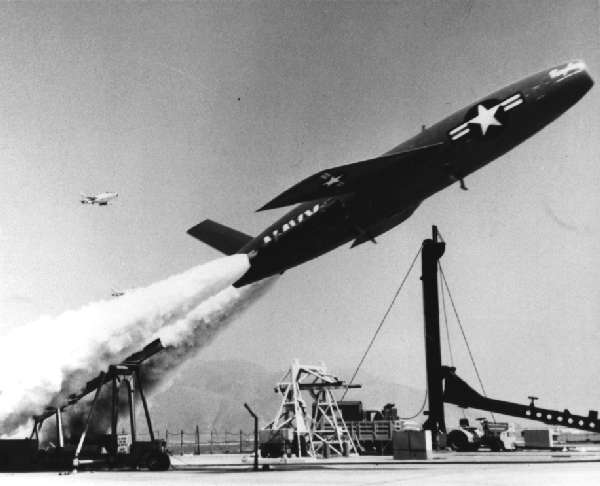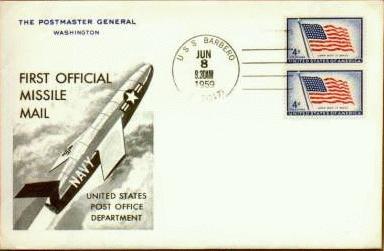These days with our lightening fast internet connections it’s easy to forget how people were always thinking of ways to shift their envelopes around the place that little bit faster, and what could be faster than blasting it into orbit in an enormous rocket?
Rocket mail has been attempted by various organizations in many different countries, with varying levels of success. Sadly it has never become a viable option for delivering mail, due to the cost of the schemes and numerous failures.
Freidrich Schmeidel launched the first rocket mail with 102 pieces of mail between two neighbouring villages in Austria. Specially printed postcards marked in German with “Flown in Instrument Rocket” bear stamps from the flights. Another teuton, Gerhard Zucker, experimented in the 1930s with simple powder rockets similar to fireworks. After moving to Britain, Zucker attempted to convince the General Post Office that postal delivery by rocket was viable. After initial demonstrations on the Sussex Downs in southern England, rockets were launched on 28 and 31 July 1934 over a 1600-metre flight path between the Hebridean islands of Harris and Scarp. Around 1.07 m long with a diameter of 18 cm, the fuselage was packed with 1,200 envelopes. Unfortunately for Zucker both rockets exploded, though most of the smaller second cargo, which included survivors of the first, was saved.
The first successful delivery of mail by a rocket in the United States was made on 23 February 1936, when two rockets that were launched from the New Jersey shore landed on the New York shore, some 300 metres away. Previously there had been some less successful attempts…
In 1959 the US Submarine, USS Barbero assisted the Post Office in its search for faster mail transportation with their first and only delivery of “Missile Mail”. On 8 June 1959, Barbero fired a Regulus cruise missile (as shown in the top picture)— the nuclear warhead having earlier been replaced by two Post Office Department mail containers — at the Naval Auxiliary Air Station in Mayport, Florida. Twenty-two minutes later, the missile struck its target.
The USPS had officially declared Barbero a branch post office, and delivered some 3000 pieces of mail to it before Barbero left Norfolk, Virginia. The mail consisted entirely of commemorative first day covers addressed to President Eisenhower, other government officials, the Postmasters General of all members of the Universal Postal Union, and so on. Their postage (four cents domestic, eight cents international) had been stamped “USS Barbero Jun 8 9.30am 1959” before the boat put to sea. In Mayport, the smouldering Regulus was opened and the mail forwarded to the post office in Jacksonville, for sorting and routing.
Upon witnessing the missile’s landing, Summerfield, the Postmaster General proclaimed the event to be “of historic significance to the peoples of the entire world”, and predicted that “before man reaches the moon, mail will be delivered within hours from New York to California, to Britain, to India or Australia by guided missiles. We stand on the threshold of rocket mail.”
In reality the Department of Defense saw the launch more as a demonstration of U.S. missile capabilities. To this day, most experts believe that the cost of using missile mail could never be justified.
However, some Technologists like Robert Zubrin, of Mars Society fame, think that rocket mail, or at least ultra-elite business package delivery may become commercially viable with the development of fully reusable rocket systems, particularly single-stage to orbit vehicles. Such systems would allow package delivery anywhere in the world in 30–45 minutes.
The collection of stamps and envelopes used for rocket mail, including envelopes sent to space, is a specialist, and rather obscure, branch of aerophilately known as astrophilately.













Fascinating stuff, Worm.
How well I remember Britain’s very own Blue Streak, designed to carry a multi-megaton nuclear bomb to the USSR, and tested to perfection at the Woomera range in Australia. But this was the fifties, and with costs escalating (never use ‘rocketing’), plans to flatten Moscow were ditched. The MOD then passed the rocket to Royal Mail, slightly shamefaced that the project had almost bankrupted the country, and suggested it be used to bridge the postal gap between New Brighton and Liverpool. The new owners of the rocket wanted a grand opening to the service and planned to put Cilla Black in the parcel bay, but Cilla’s response “Surprise Surprise, not bloody likely” scuppered the plan. They then turned to an up-and-coming Scouse group called the Pacemakers and asked if the lead singer would like to take this golden opportunity? The group immediately said yes, the flight was a great success, and the great Liverpool anthem was born: ‘Gerry Cross the Mersey’.
John, you had me going right til the end there!!!
A film based rather loosely on Zucker’s activities in the Hebrides came out seven or eight years back — called I think The Rocket Post. It goes for Local Hero-style charm and doesn’t quite pull it off, but it’s worth a look for the scenery alone if it comes up on TV some time.
I’m greatly enjoying these posts, by the way: they already seem part of the weekend routine.
A Wormer von Braun of a post and further to John Halliwell’s comment, the Blue streak, when part of the Euro project, worked every time, the next stage, the French bit, failed every time. The night sky at Twice Brewed in west Northumberland was often ablaze, as the engines were live tested at night at Spadeadam. The rocket was shipped in a special cradle, stored and maintained at Hawker Siddeley’s Gunnels Wood Rd Stevenage facility and used as the costing mule for any minor project overrun or expensive clanger, the final costing must have been eye watering even in those halcyon days of cost plus. Both the Blue Streak and its cradle can be viewed at the excellent National Museum of Flight in East Lothian. As can the Concorde, another piece of British precision engineering wot I was involved with.
Thank you Jonathan and Malty!
I love that Eisenhower ‘atomic’ era when people thought that science would make just about anything possible, and we’re prepared to try just about anything as long as it involved bombs/rockets/insane death machines
I’ve heard of Rocket Man but never Rocket Mail – so thanks for this post, Worm – and John’s curiously convincing comment also had me wondering for a while, especially as my father worked on the Blue Streak project. Anything would be an improvement on the current postal service to America – flying pigs, perhaps?
The British genius for inventing world-changing things then making a balls-up of funding development and completion has intrigued and disappointed for years. The excitement was great when the plans were announced for the TSR-2, the APT and others, only to have hopes dashed a few years later when the BBC newsreader, Kenneth Kendall, looking suitably grim-faced, would state: “The Government has today announced the cancellation of the MTRS-1, the groundbreaking Man Through the Rings of Saturn project, due to a rather large overspend on the protective shield. The Minister said that the setback would not deter the Government in its aim to keep Britain at the forefront of technological advancement, and the MTRS-1 would be replaced by the CBR100, the revolutionary Clockwork Bunny Rabbit project which it is hoped will resolve the myxomatosis problem once and for all.” But greatest excitement for me was when I watched Professor Eric Laithwaite on a small black and white tv screen demonstrating his work on the development of linear induction motors and the possibilities it opened-up for transport systems. But what happened to it in Britain? Bugger all! I bet the Japanese and others were forever watching Britain and waiting for another discarded gem to come along.
My apologies to Worm and Susan for any misleading aspects in my earlier comment, and this ramble, the sole justification for which is to pay homage to a brilliant man:
http://en.wikipedia.org/wiki/Eric_Laithwaite